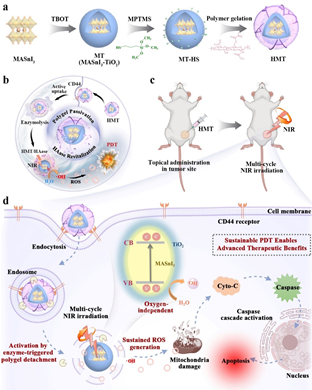Recently, the team of Prof. Ding Yang/Zhou Jianping from our school published a new paper in Chemical Engineering Journal (IF: 15.1), a top journal in the field of science under the title Perovskite-derived pro-photosensitizer enables sustainable photodynamic therapy in hypoxia tumors. The first author is Hao Cheng, a postdoctoral fellow of our school, and Prof. Yang Ding, Prof. Jianping Zhou, and Associate Researcher Zhang Huaqing are the corresponding authors. CPU is the unique correspondence affiliation.
Photodynamic therapy (PDT) is a effective strategy for tumour elimination, but its high tissue oxygen partial pressure dependence severely limits its efficacy in hypoxic tumours, so the development of non-oxygen-dependent photosensitizers is key to the use of PDT for hypoxic tumour treatment. Chalcogenide has great potential in PDT with its ultra-high photocatalytic efficiency, but its inherent defects such as easy to hydrolysis and poor safety have led to the wide gap in biomedicine research. This study innovatively develops sandwich-structured enzyme-sensitive chalcogenide photosensitizers, which overcame water instability by coating TiO2 , an electron-hole transfer mediator, on chalcogenide surfaces, and blunted its photosensitizing activity by click-modification of enzyme-responsive polymeric gel on the surfaces to promote biostabilisation and safety, tumour specific penetration, and intracellularization. After multiple runs of near-infrared irradiation following local administration to oxygen-depleted tumours, the calcitriol photosensitizer has achieved complete tumour elimination, providing new ideas and techniques for the advance of novel photodynamic therapies.
The study has been funded by the National High-level Young Talents Program, the National Natural Science Foundation of China and the Double First-class Construction of CPU.
Original link:https://www.sciencedirect.com/science/article/pii/S1385894723021885



